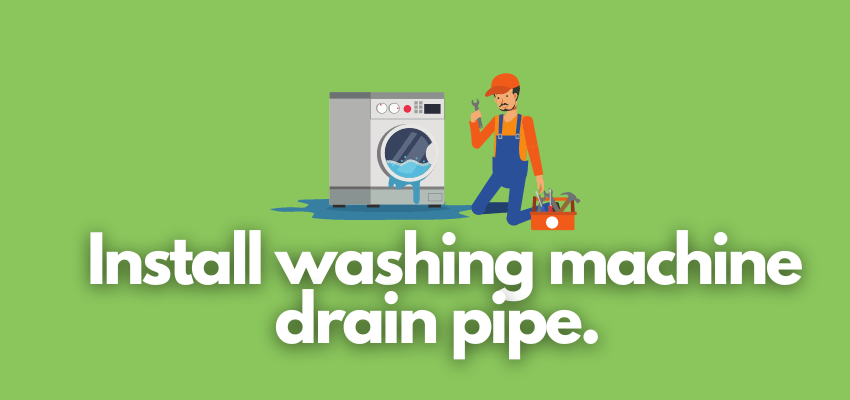Table of Contents
Last Updated on: 18th July 2023, 05:48 pm
Most first-time washing machine users get confused about installing the washing machine and call the plumber to do it. Well, installing the washing machine drain pipe is one of the basic washer installation processes and it’s vital to understand how it is done.
Before we jump straight to the step-by-step process of installing the washing machine drain pipe, it’s necessary to elaborate on what it is and how it works.
A washing machine drain pipe is a hose that connects the washing machine to a drain or sewer line. It is used to carry away wastewater from the washing machine so that the washing machine moves to the next step, which is drying the clothes.
| Disclaimer: As an Amazon Associate, I earn from qualifying purchases. |
The drain pipe is typically made of plastic or rubber and is about 1-2 inches in diameter. It is important to make sure that the drain pipe is properly installed and secured to prevent leaks.
It doesn’t matter whether a washing machine drains water automatically or manually – both types of washers have drain pipes that should be taken care of when installing the washers.
The washing machine drain pipe is an important part of the washing machine’s plumbing system. It allows the wastewater from the washing machine to be safely and efficiently disposed of.
Without a properly functioning drain pipe, the washing machine could overflow and cause water damage to the surrounding area.
Here are some tips for keeping your washing machine drain pipe in good condition:
- Inspect the drain pipe regularly for leaks or cracks.
- Clean the washer’s drain pipe to avoid clogs.
- Use a drain snake to clear any clogs that do occur.
- Replace the drain pipe if it is damaged or worn.
By following these tips, you can help to ensure that your washing machine drain pipe will last for many years to come.
Here is some additional information about washing machine drain pipes:
- The drain pipe should be installed so that it slopes down towards the drain or sewer line. This will help to prevent water from backing up into the washing machine.
- The drain pipe should be secured to the washing machine and the drain or sewer line with hose clamps. This will help to prevent the pipe from coming loose and causing a leak.
- The drain pipe should be located in a location that is easy to access for cleaning and maintenance.
By following these guidelines, you can help to ensure that your washing machine drain pipe will function properly for many years to come.
How to Install a Washing Machine Drain Pipe
Here is a step-by-step process for installing a washing machine drain pipe:
Gather the necessary materials and tools:
- Washing machine drain pipe
- PVC pipe (if needed)
- PVC fittings (elbows, couplings, etc.)
- Hacksaw or PVC pipe cutter
- PVC primer and cement
- Measuring tape
- Pliers or adjustable wrench
- Screwdriver
- Level
- Pipe hangers or straps
- Safety goggles and gloves
Determine the drainage route
When determining the drainage route for the washing machine drain pipe, you need to consider the location where you want to install it and the distance to the main drain or sewer line.
It’s important to choose a route that provides a downward slope for efficient drainage. Gravity helps the water flow smoothly through the pipe and prevents any potential clogs or backups.
Measure and cut the pipe
To install the washing machine drain pipe, you’ll need to measure the distance from the washing machine to the drain or sewer line. Once you have the measurements, mark them on the PVC pipe.
Then, using a hacksaw or PVC pipe cutter, cut the pipe to the desired length. Ensure that the cut is clean and straight for a proper fit.
Attach the fittings
The next step is to attach the necessary fittings to the PVC pipe. Apply PVC primer to the outside of the pipe end and the inside of the fitting. This helps to clean and prepare the surfaces for a strong bond.
Then, apply PVC cement to the primed areas and connect the fittings, such as elbows or couplings, to the pipe according to your planned route. It’s important to ensure that the fittings are securely attached and properly aligned.
Connect the pipe to the washing machine
Locate the washing machine’s drain outlet, typically located at the back. Measure the distance from the outlet to the pipe you’ve installed. Cut a section of PVC pipe to connect the washing machine’s drain outlet to the main drain pipe.
Attach the pipe to the washing machine’s outlet and the main drain pipe using the same process as in step 4, using PVC primer and cement to create a secure connection.
Secure the pipe
To ensure stability and prevent any movement or damage, it’s important to secure the washing machine drain pipe. Use pipe hangers or straps to attach the pipe to the wall or floor.
Space the hangers or straps evenly along the length of the pipe to provide adequate support. Additionally, make sure the pipe is level and securely fastened to avoid any strain on the connections.
Test for leaks
After the installation is complete, it’s crucial to test the washing machine drain pipe for any leaks. Turn on the water supply to the washing machine and let water flow through the drain pipe.
Check for any signs of leaks at the connections or joints. If you detect any leaks, turn off the water supply and recheck the connections and fittings. Ensure that they are properly tightened and sealed.
Adjust as necessary
If you encounter issues with drainage efficiency or leaks during the testing phase, adjustments may be required. Check the slope of the pipe to ensure proper drainage.
It should have a gradual downward slope towards the main drain or sewer line. Additionally, verify that all connections are securely tightened and properly sealed to prevent any leaks or water backups.
Clean up
Once the installation is successful, it’s important to clean up any excess primer or cement. Use a clean cloth to wipe away any residue. Dispose of any waste materials, such as cuttings or scraps, properly. Cleaning up after the installation ensures a tidy and safe environment.



